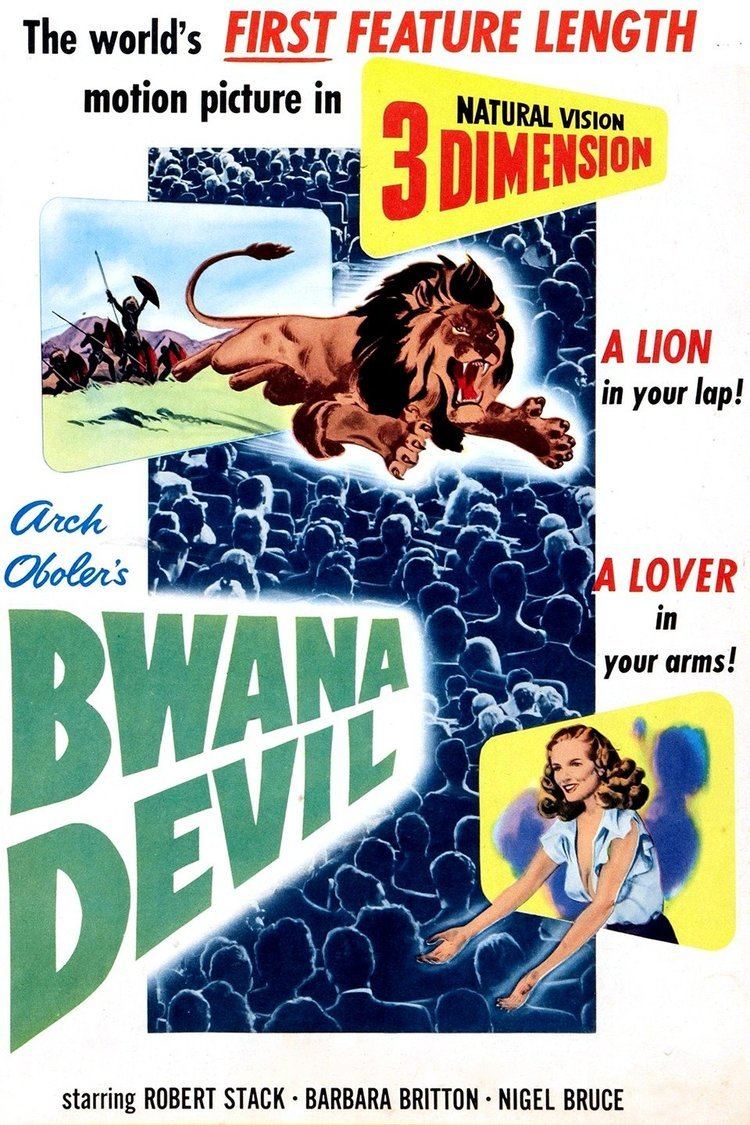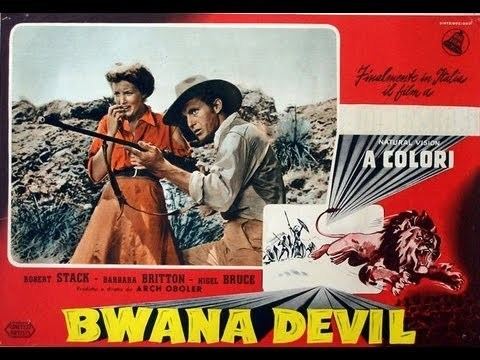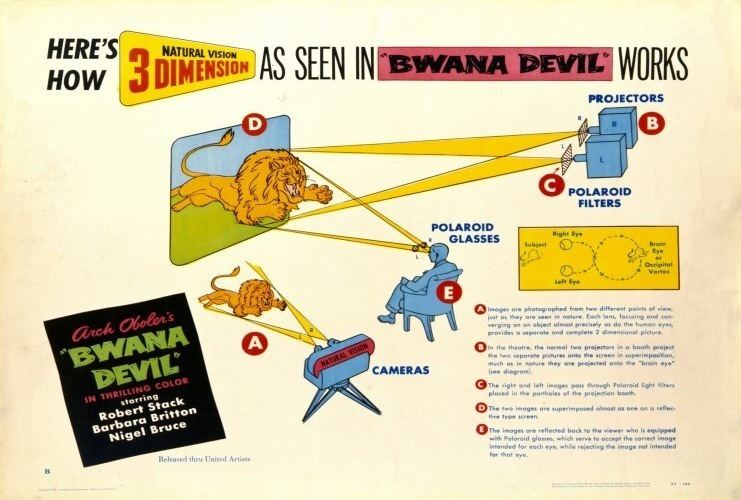Bwana Devil
4.6 /10 1 Votes4.6
4.1/10 Letterboxd Genre Adventure Language English | 4.9/10 IMDb Budget 400,000 USD Duration Country United States | |||||||||||||||||||||||||||||||||
 | ||||||||||||||||||||||||||||||||||
Release date November 30, 1952 (1952-11-30) Cast Similar movies The Ghost and the Darkness (1996), Killers of Kilimanjaro (1959), Safari (1955), Golden Ivory (1957), Tanganyika (1954) | ||||||||||||||||||||||||||||||||||
Tsavo man eaters bwana devil pt 2 of 5
Bwana Devil is a 1952 U.S. adventure film based on the true story of the Tsavo maneaters and filmed with the Natural Vision 3-D system. The film is notable for sparking the first 3-D film craze in the motion picture industry, as well as for being the first feature-length 3-D film in color and the first 3-D sound feature in English. Bwana Devil was written, directed and produced by Arch Oboler and stars Robert Stack, Barbara Britton and Nigel Bruce.
Contents
- Tsavo man eaters bwana devil pt 2 of 5
- 1952 bwana devil bande annonce
- Plot
- Historic background
- Natural Vision
- Production
- Release
- Commercial Reception
- Reviews
- In popular culture
- Availability
- References

The advertising tagline was: The Miracle of the Age!!! A LION in your lap! A LOVER in your arms!

1952 bwana devil bande annonce
Plot

The film is set in British East Africa in the early 20th century. Thousands of workers are building the Uganda Railway, Africa's first railroad, and intense heat and sickness make it a formidable task. Two men in charge of the mission are Jack Hayward and Dr. Angus Ross. A pair of man-eating lions are on the loose and completely disrupt the undertaking. Hayward desperately attempts to overcome the situation, but the slaughter continues.

Britain sends three big-game hunters to kill the lions. With them comes Jack's wife. After the game hunters are killed by the lions, Jack sets out once and for all to kill them. A grim battle between Jack and the lions endangers both Jack and his wife. Jack kills the lions and proves he is not a weakling.
Historic background

The plot was based on a well-known historical event, that of the Tsavo maneaters, in which many workers building the Uganda Railway were killed by lions. These incidents were also the basis for the book The Man-eaters of Tsavo (1907), the story of the events as written by Lt. Col. J. H. Patterson, the British engineer who killed the animals. The story was also the basis for the film The Ghost and the Darkness (1996) with Michael Douglas and Val Kilmer.
Natural Vision
By 1951 film attendance had fallen dramatically from 90 million in 1948 to 46 million. Television was seen as the culprit and Hollywood was looking for a way to lure audiences back. Cinerama had premiered on September 30, 1952 at the Broadway Theater in New York and was a success there, but its bulky and expensive three-projector system and huge curved screen were impractical, if not impossible, to duplicate in any but the largest theaters.
Former screenwriter Milton Gunzburg and his brother Julian thought they had a solution with their Natural Vision 3-D film process. They shopped it around Hollywood. 20th Century Fox was focusing on the introduction of CinemaScope and had no interest in another new process. Both Columbia and Paramount passed it up.
Only John Arnold, who headed the Metro-Goldwyn-Mayer camera department, was impressed enough to convince MGM to take an option on it, but they quickly let the option lapse. Milton Gunzburg turned his focus to independent producers and demonstrated Natural Vision to Arch Oboler, producer and writer of the popular Lights Out radio show. Oboler was impressed enough to option it for his next film project.
Production
Oboler and co-producer Sid Pink scrapped ten days of footage they had shot for The Lions of Gulu and started over using the Natural Vision process.
The title of Oboler's film was ultimately changed to Bwana Devil.
The Paramount Ranch, now located in The Santa Monica Mountains National Recreation Area, sat in for an African savanna. There is now a hiking trail in the area named "The Bwana Trail" to denote the locations used in Bwana Devil. Authentic African footage shot by Arch Oboler in 1948 (in 2-D) was incorporated into the film. Ansco Color film was used, instead of the more expensive and cumbersome Technicolor process.
Release
The film premiered under the banner of "Arch Oboler Productions" on November 26, 1952 with a twin engagement at the Paramount Theaters in Hollywood and downtown Los Angeles. As at all U.S. screenings of feature-length 3-D films in the 1950s, the polarized light method was used and the audience wore 3-D glasses with gray Polaroid filters. The anaglyph color filter method was only used for a few short films during these years. The two-strip Natural Vision projection system required making substantial alterations to a theater's projectors and providing its screen with a special non-depolarizing surface.
The film was a critical failure, but a runaway success with audiences. It opened in San Francisco on December 13, Philadelphia, Dallas, Houston and San Antonio on December 25, and New York on February 18, 1953. M.L. Gunzburg presents 3-D, a short film produced by Bob Clampett and featuring Beany and Cecil, was screened preceding the film. Long thought lost, the short rejoined Bwana Devil for screenings at the Egyptian Theater in 2003 and 2006.
United Artists bought the rights to Bwana Devil from Arch Oboler Productions for $500,000 and a share of the profits and began a wide release of the film in March as a United Artists film. A lawsuit followed, in which producer Edward L. Alperson Jr. claimed that he was part owner of the film after purchasing a share of it for $1,000,000 USD. The courts decided in Oboler's favor, as Alperson's claim was unsubstantiated and "under the table".
The other major studios reacted by releasing their own 3-D films. Warner Brothers optioned the Natural Vision process for House of Wax. It premiered on April 10, 1953 and was advertised as "the first 3-D release by a major studio". In truth, Columbia had trumped them by two days with their release of Man in the Dark on April 8, 1953.
Commercial Reception
The movie earned $2.7 million in rentals in North America in 1953. United Artists ultimately ended up recording a loss of $200,000 on the film.
Reviews
In popular culture
Life magazine photographer J. R. Eyerman took a series of photos of the audience wearing 3D glasses at the premiere. One of the photos was published as a full page in the magazine and has become iconic. It was also used as the cover of Life, The Second Decade, 1946–1955, a book published in conjunction with an exhibition of photographs from Life held at the International Center of Photography, New York. Guy Debord used one of the photos as a symbol of alienation under capitalism, for the cover of his film The Society of the Spectacle (1973). The photo Debord used shows the audience in "a virtually trance-like state of absorption, their faces grim, their lips pursed". However, in the one chosen by Life, "the spectators are laughing, their expressions of hilarity conveying the pleasure of an uproarious, active spectatorship." The Debord version is also flipped left to right and cropped.
Availability
References
Bwana Devil WikipediaBwana Devil IMDbBwana Devil LetterboxdBwana Devil themoviedb.org
